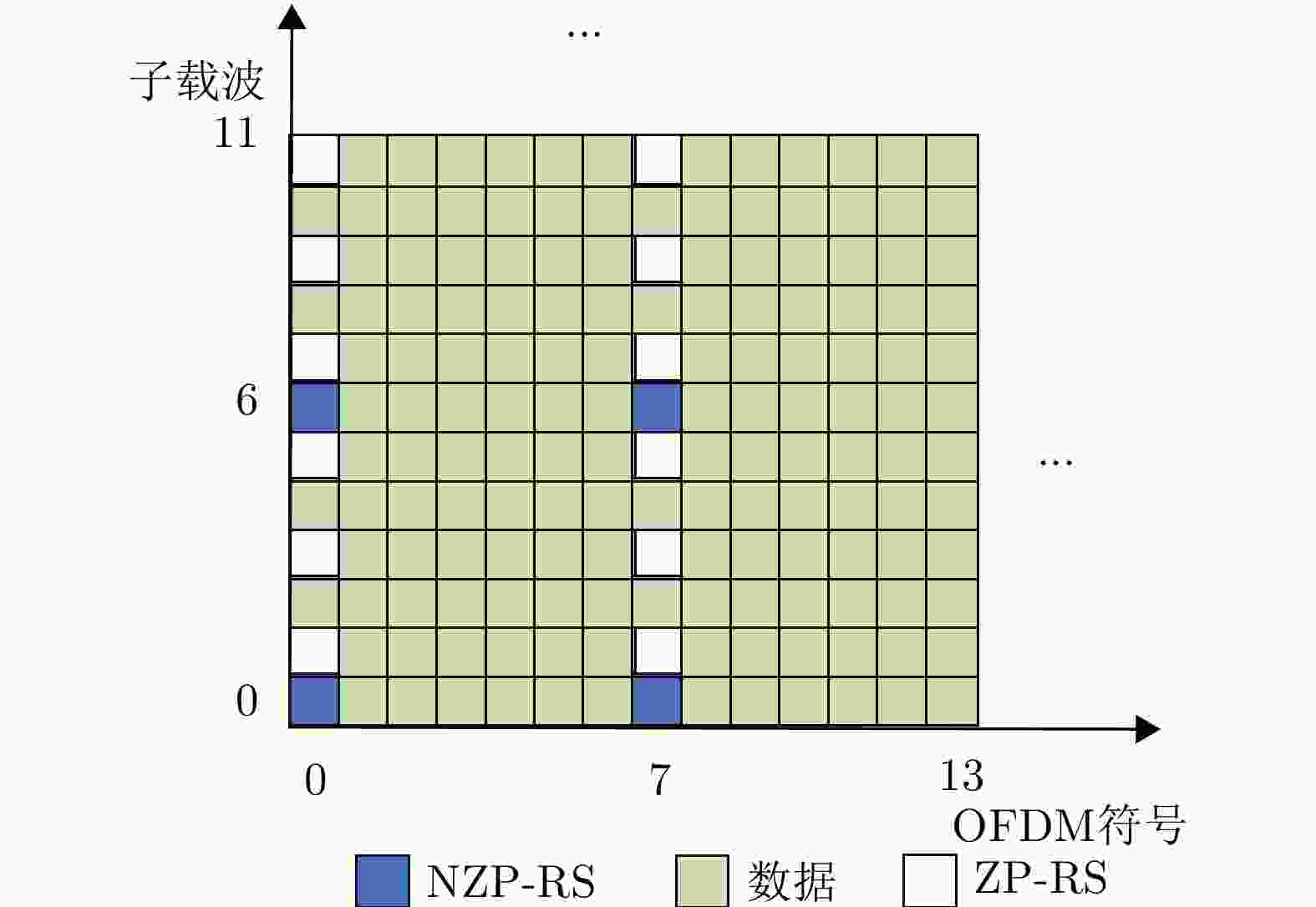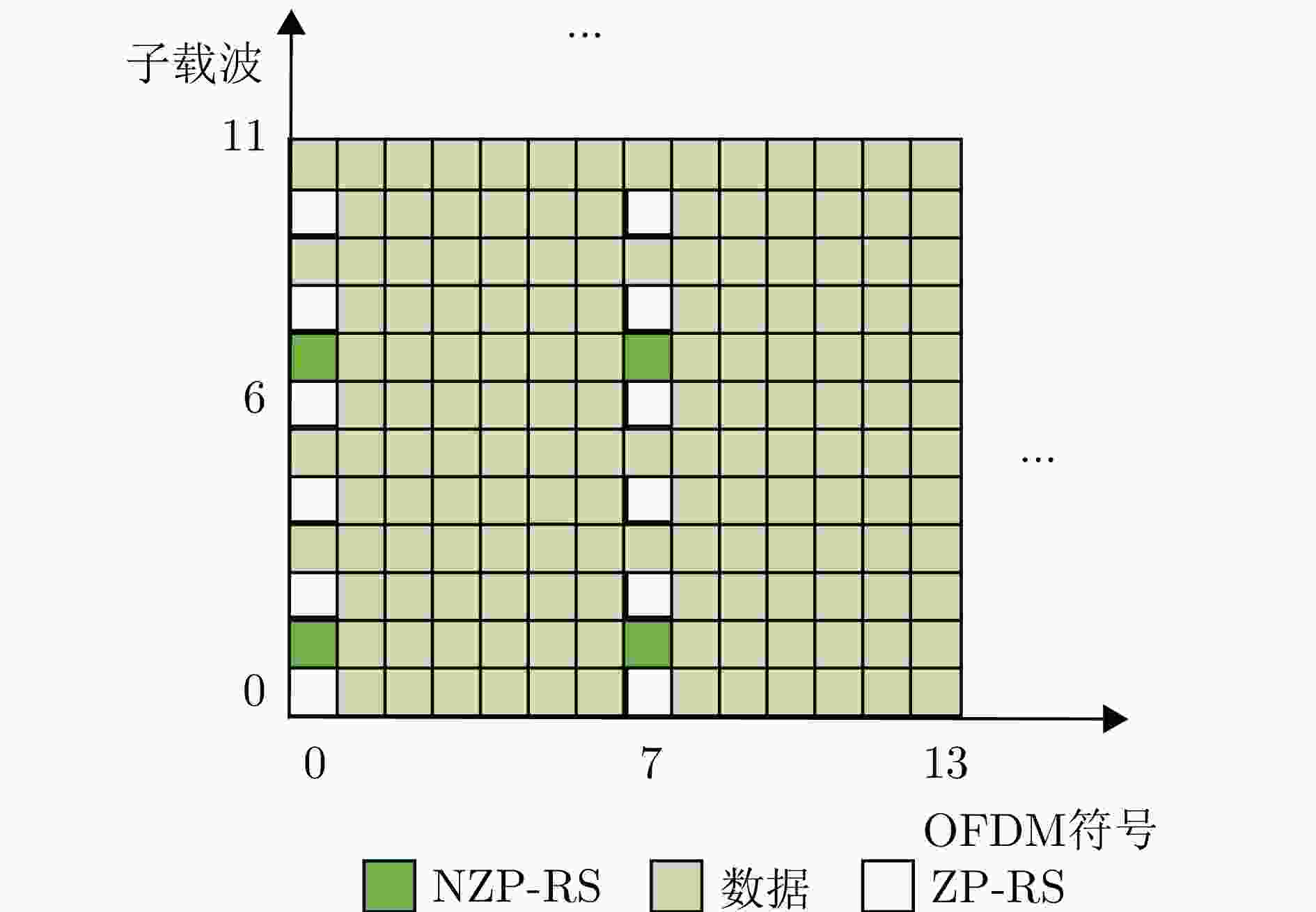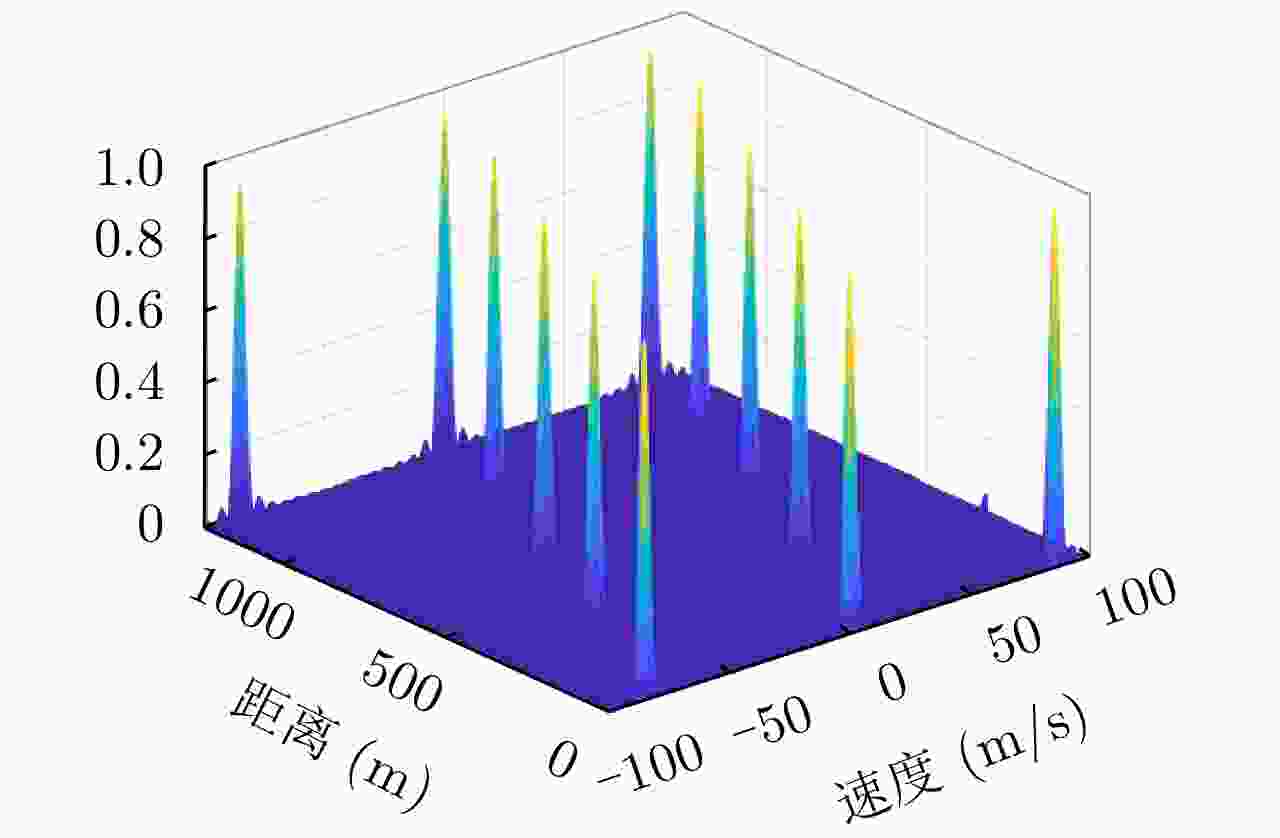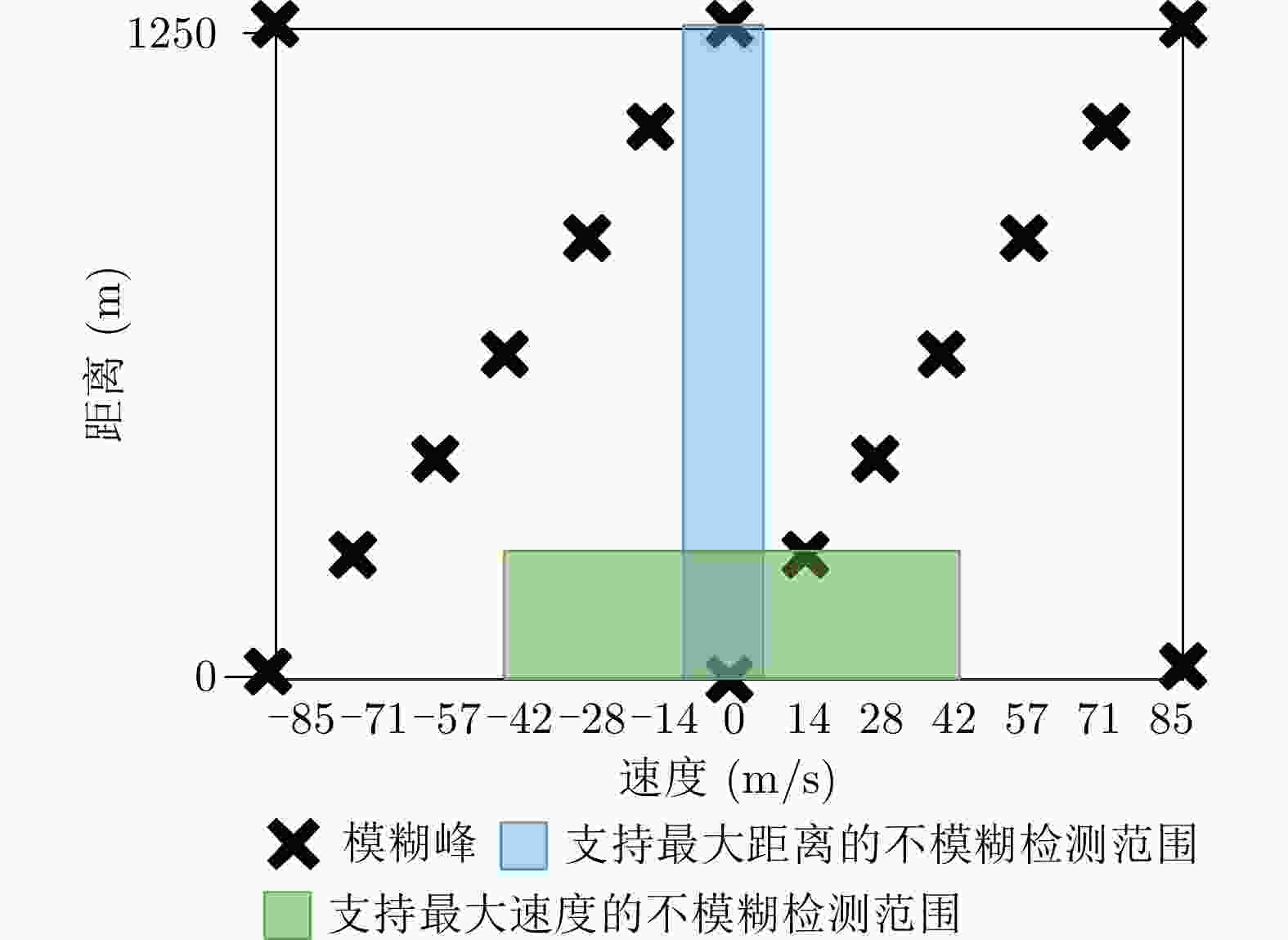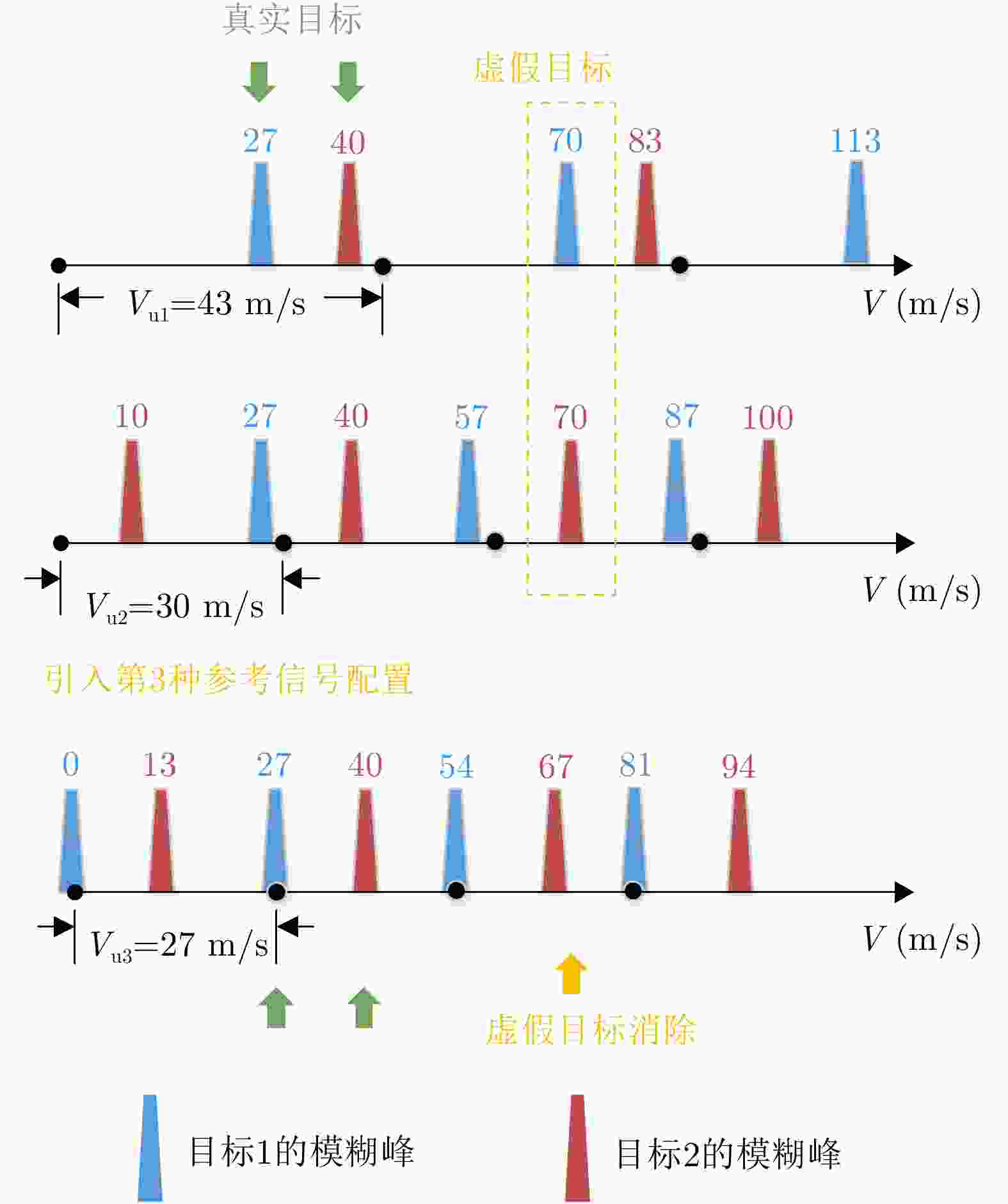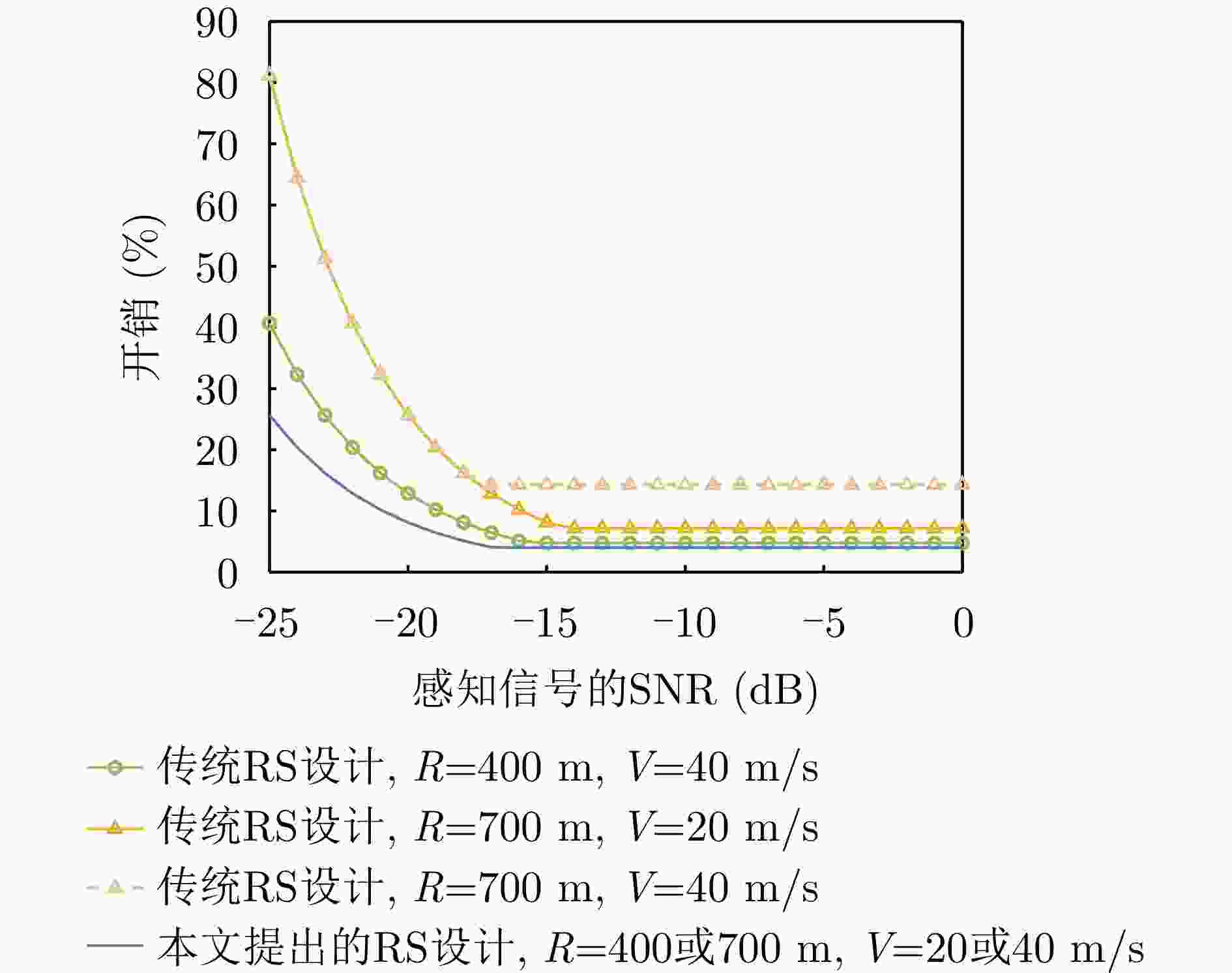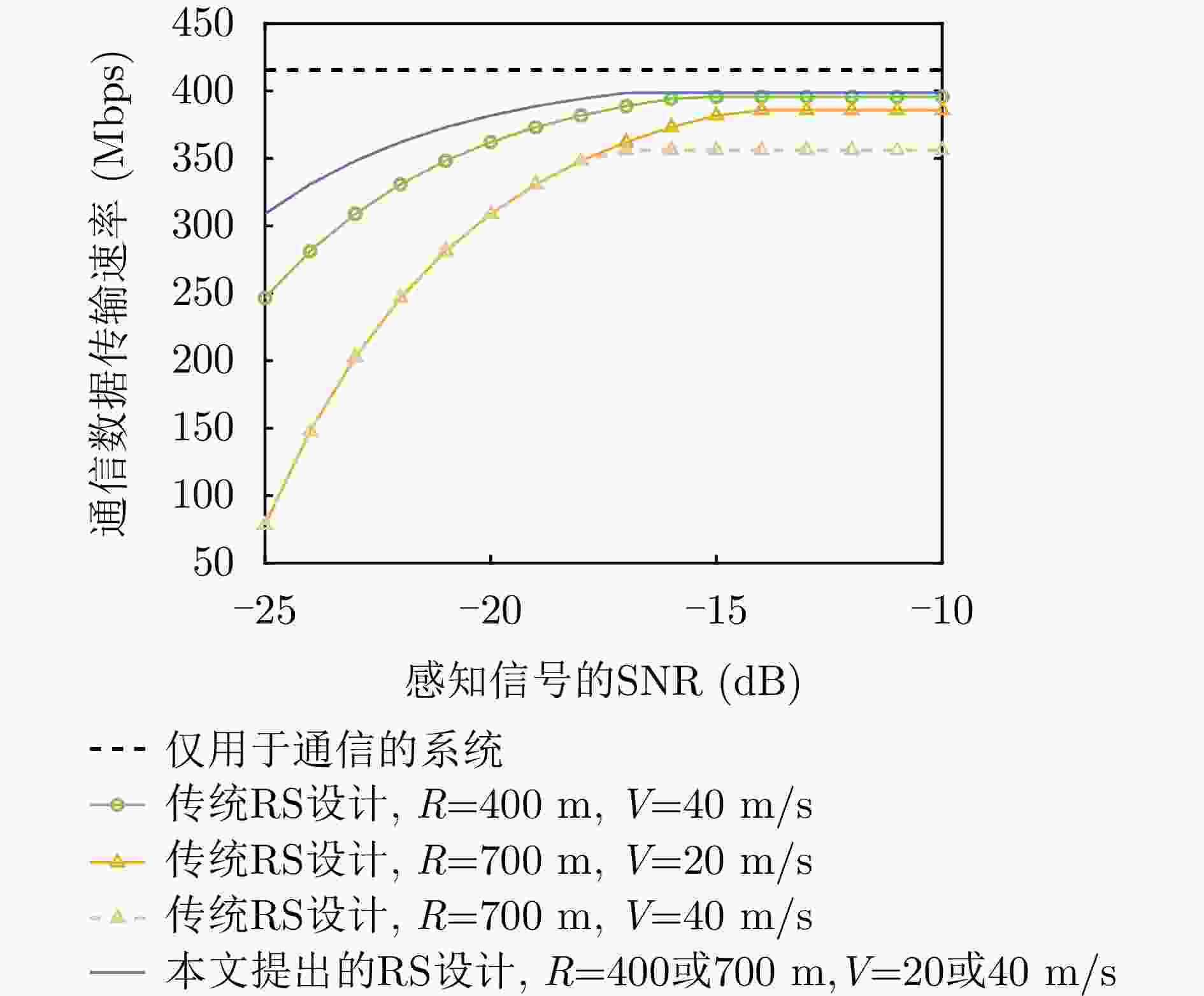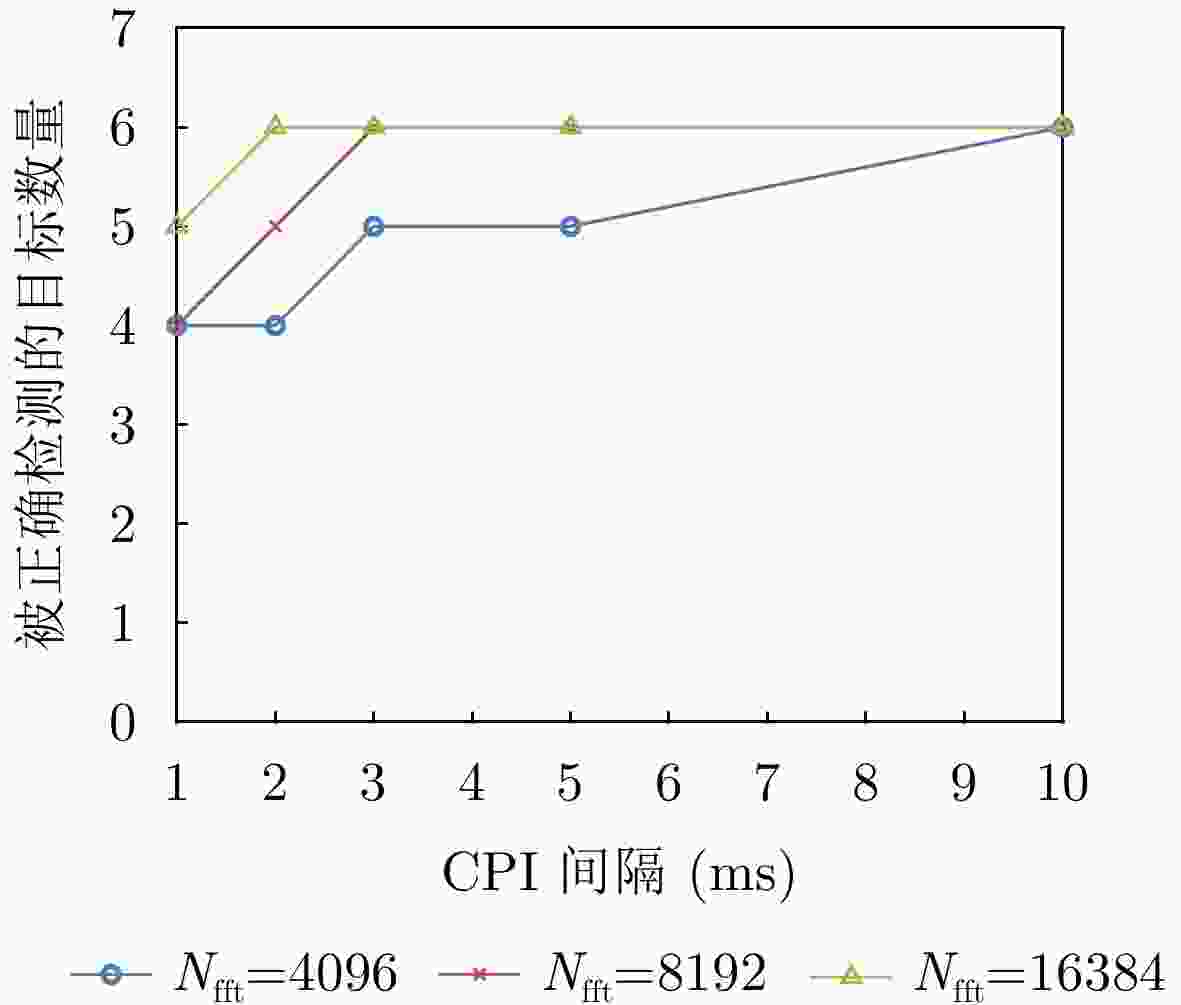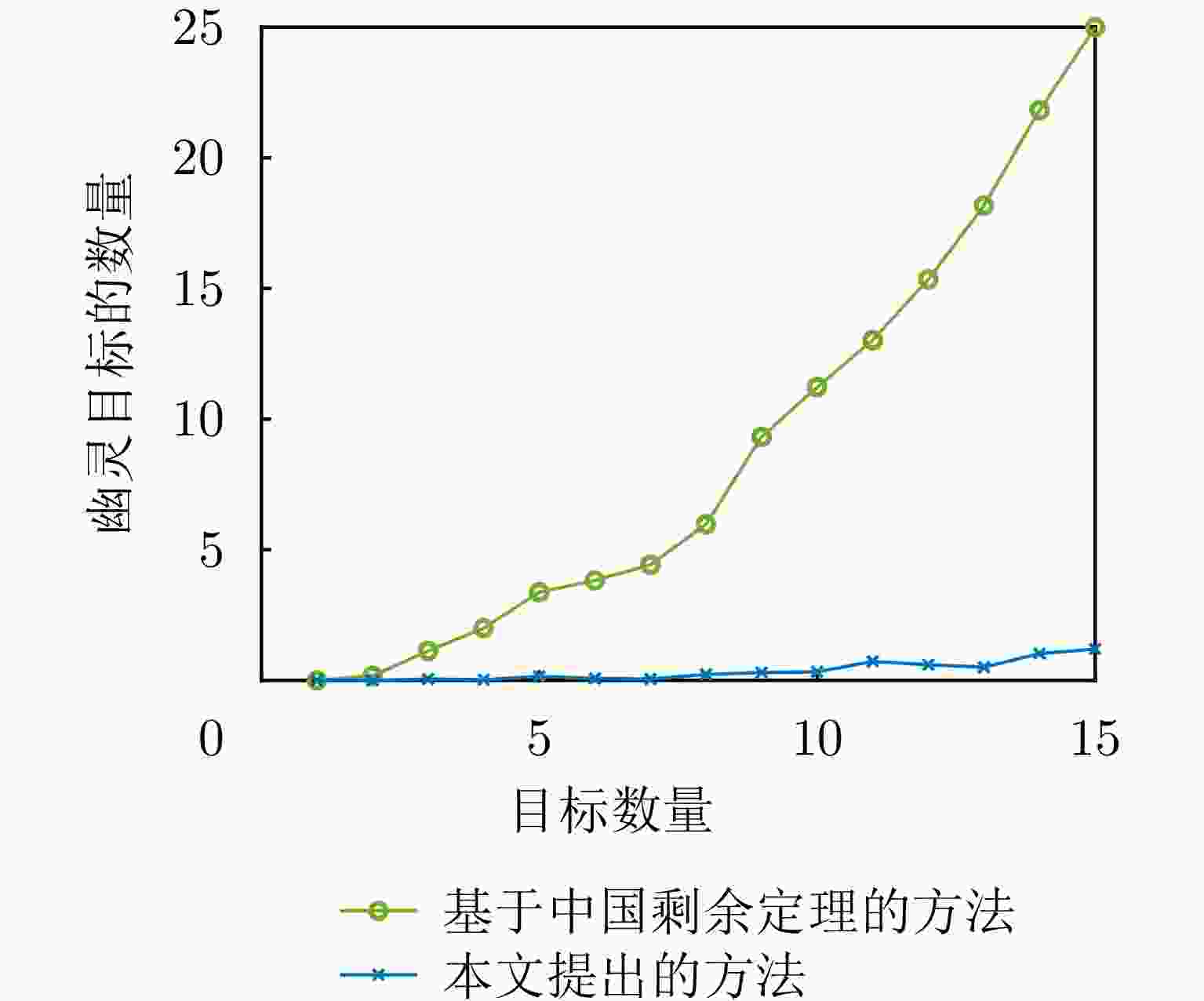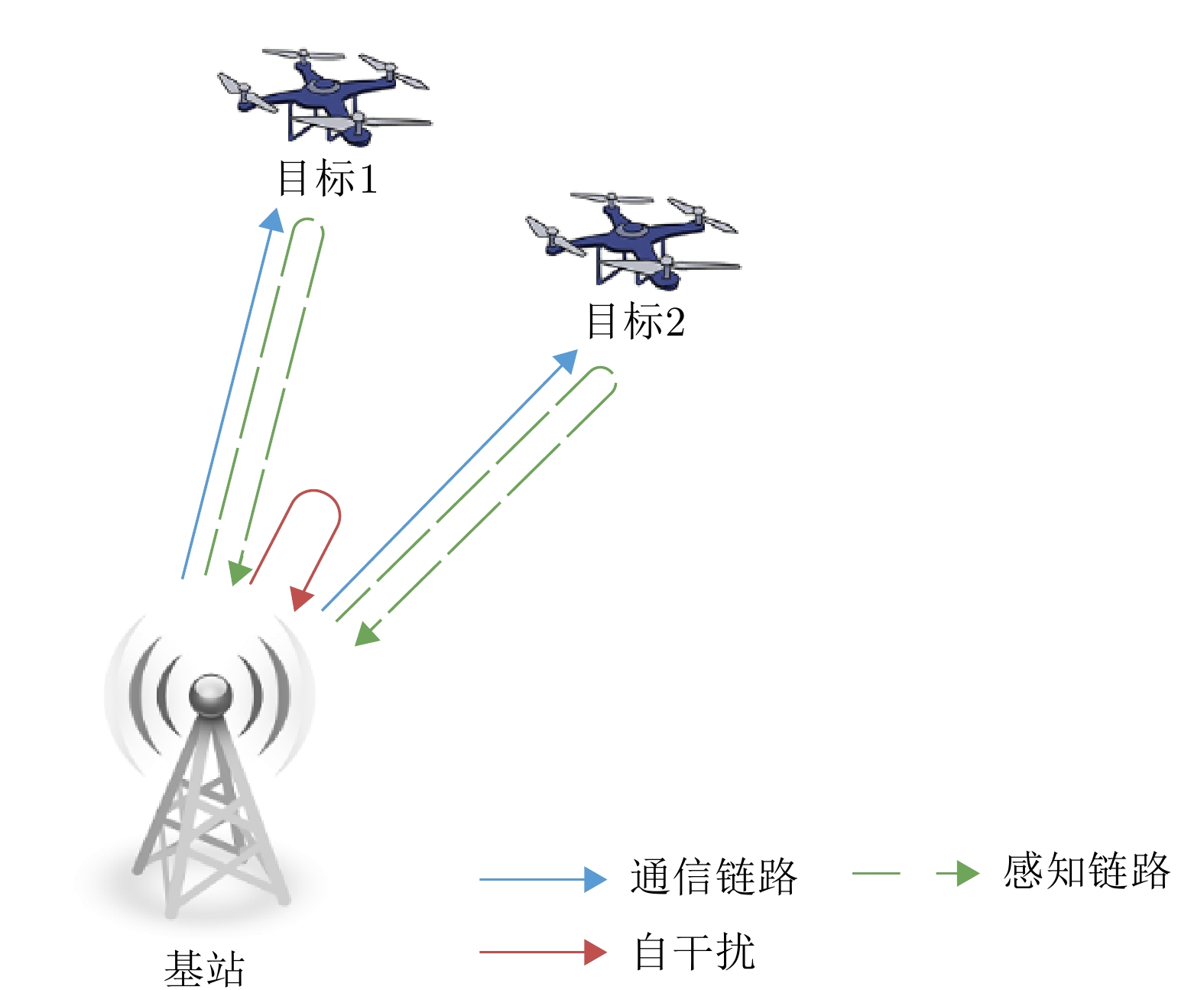-
摘要: 随着低空经济的兴起,无人机的通信和检测问题受到了广泛的关注。该文研究了OFDM通信感知一体化中的感知参考信号设计,用于远距离高速无人机的检测。为了实现无人机在远距离和高速度情况下的不模糊检测,传统的参考信号设计需要较密的感知参考信号布置,从而带来较大的资源开销。此外,基于OFDM波形的远距离检测,还面临码间串扰的挑战。首先,针对远距离检测的问题,该文设计了支持远距离检测且抗码间串扰的感知参考信号模式,可以在较少资源开销下达到系统的最大不模糊检测距离。然后,基于前述参考信号的排布模式,针对高速度检测的问题,该文在基于中国剩余定理消除模糊方法的基础上,引入距离变化率。通过合理的参考信号配置与幽灵目标消除算法,可以在较小的资源开销下,大幅增加不模糊检测速度,且有效避免幽灵目标的产生。上述方法的有效性最后通过仿真进行了验证。仿真结果表明,针对远距离高速目标的检测,相比于传统方法,该文所提的方法可降低72%的参考信号开销。Abstract: With the emergence of the low-altitude economy, the communication and detection issues of Unmanned Aerial Vehicles (UAVs) have gained considerable attention. This paper investigates sensing reference signal design for Integrated Sensing And Communication (ISAC) in Orthogonal Frequency Division Multiplexing (OFDM) systems aimed at detecting long-range, high-speed UAVs. To address the ambiguity problem in long-range and high-speed UAV detection, traditional reference signal designs require densely arranged reference signals, leading to significant resource overhead. In addition, long-range detection based on OFDM waveforms faces challenges from Inter-Symbol Interference (ISI). To address these issues, this paper first proposes a reference signal pattern that supports long-range detection and resists ISI, achieving the maximum unambiguous detection range of the system with reduced resource overhead. Then, to address the challenge of high-speed detection, the paper incorporates range-rate into the Chinese Remainder Theorem-based method. Through the proper configuration of sensing reference signals and the cancellation of ghost targets, this approach significantly increases the unambiguous detection velocity while minimizing resource usage and avoiding the generation of ghost targets. The effectiveness of the proposed methods is validated through simulations. Simulation results show that compared with the traditional sensing reference signal design, our proposed scheme can reduce 72% overhead of reference signals for long-range and high-speed UAV detections.
-
1 基于中国剩余定理和距离变化率的目标检测流程
1. Target detection procedure based on CRT and range-rate
输入:两次CPI的RD谱$ {\text{RD}}_{1} $, $ {\text{RD}}_{2} $ 输出:估计的距离-速度对$ ({R}^{i},{V}^{i})\text{,}\;i=1,2,\cdots,I $ 1. 从$ {\text{RD}}_{1} $获取峰值,记为$ \left({R}_{1}^{i},{V}_{\mathrm{a}1}^{i}\right)\text{,}\;i=1,2,\cdots, I $,根据$ {V}_{\mathrm{a}1}^{i} $和$ {V}_{\mathrm{u}1} $得到第i个目标在第1个CPI的速度可能取值集合$ {\mathbb{S}}_{1}^{i} $ 2. 从$ {\text{RD}}_{2} $获取峰值,记为$ \left({R}_{2}^{j},{V}_{\mathrm{a}2}^{j}\right)\text{,}\;j=1,2,\cdots,I $,根据$ {V}_{\mathrm{a}2}^{j} $和$ {V}_{\mathrm{u}2} $得到第j个目标在第2个CPI的速度可能取值集合$ {\mathbb{S}}_{2}^{j} $ 3. 通过聚合的方式比较两个CPI获得的所有速度可能取值,即比较集合$ \left\{x\right|x\in {\mathbb{S}}_{1}^{i}\text{,}\;i=1,2,\cdots ,I\} $和$ \left\{x|x\in {\mathbb{S}}_{2}^{j}\text{,}\;j=1,2,\cdots, I\right\} $,如果有一
致或接近的值,记录这个速度和它对应的在两个CPI的距离$ ({V}^{k},{R}_{1}^{k},{R}_{2}^{k})\text{,}\;k=1,2,\cdots,K(K\ge I) $4. 如果$ K > I $,根据$ {\hat{V}}^{k}=\dfrac{{R}_{2}^{k}-{R}_{1}^{k}}{{\Delta }t} $计算第k个目标的距离变化率,如果$ {\hat{V}}^{k},{V}^{k} $相差不超过$ \mathrm{m}\mathrm{i}\mathrm{n}({V}_{\mathrm{u}1},{V}_{\mathrm{u}2}) $,保留$ ({V}^{k},{R}_{1}^{k},{R}_{2}^{k}) $数组;否
则,抛弃数组5. 输出$ ({R}^{k},{V}^{k})=\left(\right({R}_{1}^{k}+{R}_{2}^{k})/2,{V}^{k})\text{,}\;k=1,2,\cdots,I $ 表 1 系统仿真物理层参数
Table 1. Physical layer parameters for system simulation
参数 数值 参数 数值 中心频率$ {f}_{\mathrm{c}} $ 28 GHz 带宽B 50 MHz 子载波间隔$ {{\Delta }}_{\mathrm{f}} $ 120 kHz 数据持续时长$ {T}_{\mathrm{d}} $ 8.3 μs CP时长$ {T}_{\mathrm{c}\mathrm{p}} $ 0.59 μs 符号持续时长$ {T}_{\mathrm{s}\mathrm{y}\mathrm{m}} $ 8.9 μs 子载波个数$ {N}_{\mathrm{c}} $ 348 OFDM符号个数$ {N}_{\mathrm{s}} $ 112 -
[1] 王宝义. 我国低空经济的技术经济范式分析与发展对策[J]. 中国流通经济, 2024, 38(9): 14–26. doi: 10.14089/j.cnki.cn11-3664/f.2024.09.002.WANG Baoyi. The technological and economic paradigm analysis and countermeasures for developing low altitude economy in China[J]. China Business and Market, 2024, 38(9): 14–26. doi: 10.14089/j.cnki.cn11-3664/f.2024.09.002. [2] MOHAMMED F, IDRIES A, MOHAMED N, et al. UAVs for smart cities: Opportunities and challenges[C]. 2014 International Conference on Unmanned Aircraft Systems, Orlando, USA, 2014. doi: 10.1109/ICUAS.2014.6842265. [3] 张博钧, 刘立平, 曹珺飞, 等. 低空经济产业标准体系规划研究[J]. 信息通信技术与政策, 2024, 50(11): 41–47. doi: 10.12267/j.issn.2096-5931.2024.11.007.ZHANG Bojun, LIU Liping, CAO Junfei, et al. Research on the planning of low-altitude economic industry standard system[J]. Information and Communications Technology and Policy, 2024, 50(11): 41–47. doi: 10.12267/j.issn.2096-5931.2024.11.007. [4] ZHANG Chen, ZHANG Leyi, ZHU Lipeng, et al. 3D deployment of multiple UAV-mounted base stations for UAV communications[J]. IEEE Transactions on Communications, 2021, 69(4): 2473–2488. doi: 10.1109/TCOMM.2021.3049387. [5] MU Junsheng, ZHANG Ronghui, CUI Yuanhao, et al. UAV meets integrated sensing and communication: Challenges and future directions[J]. IEEE Communications Magazine, 2023, 61(5): 62–67. doi: 10.1109/MCOM.008.2200510. [6] LIU Fan, CUI Yuanhao, MASOUROS C, et al. Integrated sensing and communications: Toward dual-functional wireless networks for 6G and beyond[J]. IEEE Journal on Selected Areas in Communications, 2022, 40(6): 1728–1767. doi: 10.1109/JSAC.2022.3156632. [7] ITU. Framework and overall objectives of the future development of IMT for 2030 and beyond[R]. ITU-R M.2160-0, 2023. [8] WANG Xinyi, FEI Zesong, ZHANG J A, et al. Constrained utility maximization in dual-functional radar-communication multi-UAV networks[J]. IEEE Transactions on Communications, 2021, 69(4): 2660–2672. doi: 10.1109/TCOMM.2020.3044616. [9] MENG Kaitao, WU Qingqing, MA Shaodan, et al. Throughput maximization for UAV-enabled integrated periodic sensing and communication[J]. IEEE Transactions on Wireless Communications, 2023, 22(1): 671–687. doi: 10.1109/TWC.2022.3197623. [10] MENG Kaitao, WU Qingqing, XU Jie, et al. UAV-enabled integrated sensing and communication: Opportunities and challenges[J]. IEEE Wireless Communications, 2024, 31(2): 97–104. doi: 10.1109/MWC.131.2200442. [11] EVERS A and JACKSON J A. Cross-ambiguity characterization of communication waveform features for passive radar[J]. IEEE Transactions on Aerospace and Electronic Systems, 2015, 51(4): 3440–3455. doi: 10.1109/TAES.2015.140622. [12] DAN Yangpeng, WAN Xianrong, YI Jianxin, et al. Ambiguity function analysis of long term evolution transmission for passive radar[C]. 2018 12th International Symposium on Antennas, Propagation and EM Theory, Hangzhou, China, 2018: 1–4. doi: 10.1109/ISAPE.2018.8634255. [13] CUI Yuanhao, JING Xiaojun, and MU Junsheng. Integrated sensing and communications via 5G NR waveform: Performance analysis[C]. 2022 IEEE International Conference on Acoustics, Speech and Signal Processing, Singapore, Singapore, 2022: 8747–8751. doi: 10.1109/ICASSP43922.2022.9746355. [14] WEI Zhiqing, WANG Yuan, MA Liang, et al. 5G PRS-based sensing: A sensing reference signal approach for joint sensing and communication system[J]. IEEE Transactions on Vehicular Technology, 2023, 72(3): 3250–3263. doi: 10.1109/TVT.2022.3215159. [15] ZHAO Qimin, TANG Aimin, and WANG Xudong. Reference signal design and power optimization for energy-efficient 5G V2X integrated sensing and communications[J]. IEEE Transactions on Green Communications and Networking, 2023, 7(1): 379–392. doi: 10.1109/TGCN.2023.3234392. [16] BRAUN K M. OFDM radar algorithms in mobile communication networks[D]. [Ph.D. dissertation], Karlsruher Institut für Technologie, 2014. [17] TANG Aimin, LI Songqian, and WANG Xudong. Self-interference-resistant IEEE 802.11ad-based joint communication and automotive radar design[J]. IEEE Journal of Selected Topics in Signal Processing, 2021, 15(6): 1484–1499. doi: 10.1109/JSTSP.2021.3118888. [18] WANG Lin, WEI Zhiqing, SU Liyan, et al. Coherent compensation based ISAC signal processing for long-range sensing: (Invited Paper)[C]. 2023 21st International Symposium on Modeling and Optimization in Mobile, Ad Hoc, and Wireless Networks, Singapore, Singapore, 2023: 689–695. doi: 10.23919/WiOpt58741.2023.10349853. [19] TANG Aimin, ZHAO Qimin, WANG Xudong, et al. ISI-resistant reference signal design and processing for OFDM integrated communications and long-range radar sensing[J]. IEEE Communications Letters, 2024, 28(6): 1322–1326. doi: 10.1109/LCOMM.2024.3394545. [20] RICHÉ V, MÉRIC S, BAUDAIS J Y, et al. Investigations on OFDM signal for range ambiguity suppression in SAR configuration[J]. IEEE Transactions on Geoscience and Remote Sensing, 2014, 52(7): 4194–4197. doi: 10.1109/TGRS.2013.2280190. [21] WANG Wenqin. Mitigating range ambiguities in high-PRF SAR with OFDM waveform diversity[J]. IEEE Geoscience and Remote Sensing Letters, 2013, 10(1): 101–105. doi: 10.1109/LGRS.2012.2193870. [22] MEI Dongyang, WEI Zhiqing, CHEN Xu, et al. A coprime and periodic pilot design for ISAC system[C]. 2024 IEEE Wireless Communications and Networking Conference, Dubai, United Arab Emirates, 2024: 1–6. doi: 10.1109/WCNC57260.2024.10571182. [23] HUANG Zhenxing and ZHENG Wan. Range ambiguity resolution in multiple PRF pulse Doppler radars[C]. IEEE International Conference on Acoustics, Speech, and Signal Processing, Dallas, USA, 1987: 1786–1789. doi: 10.1109/ICASSP.1987.1169906. [24] WANG Chen, YIN Qinye, and CHEN Hongyang. Robust Chinese remainder theorem ranging method based on dual-frequency measurements[J]. IEEE Transactions on Vehicular Technology, 2011, 60(8): 4094–4099. doi: 10.1109/TVT.2011.2167690. [25] AGARWAL R C. Number theory in digital signal processing[J]. Proceedings of the IEEE, 1980, 68(10): 1358–1359. doi: 10.1109/PROC.1980.11872. [26] BHARADIA D, MCMILIN E, and KATTI S. Full duplex radios[C]. ACM SIGCOMM 2013 conference on SIGCOMM, Hong Kong, China, 2013: 375–386. doi: 10.1145/2486001.2486033. -



 作者中心
作者中心 专家审稿
专家审稿 责编办公
责编办公 编辑办公
编辑办公
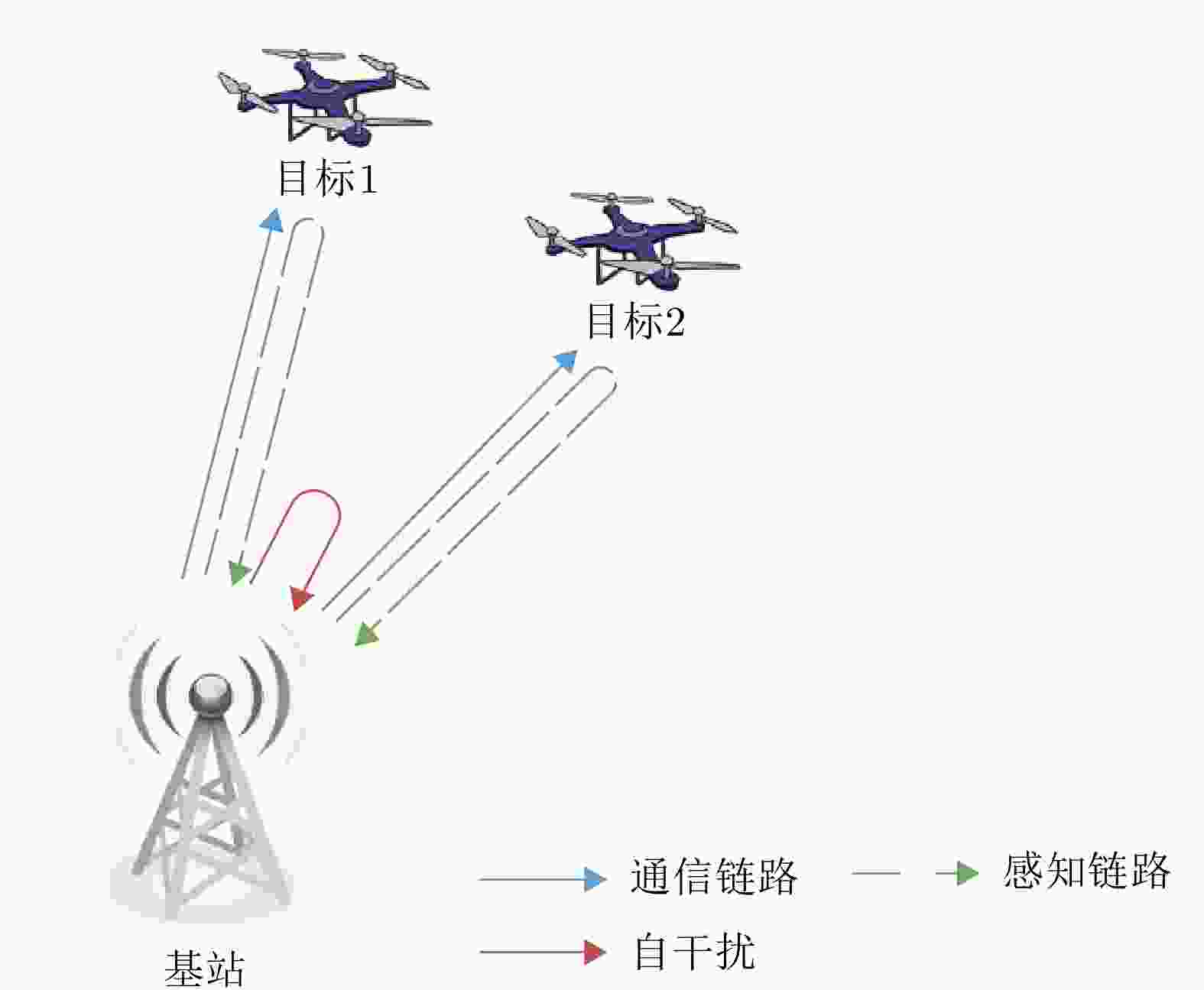
 下载:
下载:

